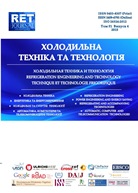ПРОВІДНІ ТЕНДЕНЦІЇ У РОЗВИТКУ ЄВРОПЕЙСЬКОГО РИНКУ ФУНКЦІОНАЛЬНИХ ПРОДУКТІВ
DOI :
https://doi.org/10.15673/0453-8307.4/2015.44785Mots-clés :
функціональні продукти, європейський ринок функціональних продуктів, збагачені продукти, здорове харчування, нутрієнтиRésumé
Розвиток суспільства диктує потребу в сучасному підході до технології виробництва продуктів харчування. Турбота про власне здоров'я стимулює попит на нові, що дозволяють підтримувати здоров'я. Функціональні харчові продукти є оптимальною основою для введення оздоровлюючих компонентів, що створюють додаткову корисність, відповідають сучасним вимогам ринку та задовольняють потреби покупця.Références
Bech-Larsen, T., Grunert, K. G., & Poulsen, J. B. (2001). The acceptance of functional foods in Denmark, Finland and the United States. MAPP working paper 73. The Aarhus School on Business.
Bellisle, F., Diplock, A. T., Hornstra, G., Koletzko, B., Roberfroid, M., Salminen, S., & Saris, W. H. M. (Eds.). (1998). Functional Food Science in Europe. British Journal of Nutrition, 80(Suppl. 1), 1 193.
Heasman, M., & Mellentin, J. (2001). The functional foods revolution. Healthy people, healthy profits? London and Sterling: Earthscan Publications Ltd.
Menrad, K. (2000). Markt und Marketing von funktionellen Leben-smitteln. Agrarwirtschaft, 49(8), 295–302.
American Dietetic Association (ADA) (2004) ‘Position of the American Dietetic Association: Functional Foods’, Journal of the American Dietetic Association 104 (5), 814-826.
Arias-Aranda D., and M. M. Romerosa-Martinez, (2010) ‘Innovation in the functional foods industry in a peripheral region of the European Union: Andalusia (Spain)’, Food Policy,35: 240-246
European Commission (EC) (2008) Characteristics and Perspectives of the Market for Food Supplements Containing Substances Other than vitamins and Minerals. Commission Staff Working Document, SEC(2008) 2976
European Food Safety Authority (EFSA) (2010) Food Supplements, Available Online at:ttp://ec.europa.eu/food/food/labellingnutrition/supplements/index_en.htm (Accessed April 2010).
Zawistowski J. (2008) ‘Regulation of Functional Foods in Selected Asian Countries in the Pacific Rim’, Nutraceutical and Functional Food Regulation in the United States and Around the World, edited by Debasis Bagchi. Burlington: Elsevier.
Verbeke W. (2006) ‘Functional Foods: Consumer Willingness to Compromise on Taste for Health’, Food Quality and Preference, 17: 126–131.
Scott Wolfe Management Inc. (2002) Potential Benefits of Functional Foods and Nutraceuticals to the Agri-Food Industry in Canada, Research conducted for Agriculture and Agri-Food Canada (AAFC), http://www.agr.gc.ca/misb/fb-ba/nutra/ben/pdf/Agrpt_e.pdf (Accessed May 2010).
Markosyan A., J. J. McCluskey, and T. I. Wahl (2009) ‘Consumer Response to Information About a Functional Food Product: Apples Enriched With Antioxidants’, Canadian Journal of Agricultural Economics, 57: 325–341.
Malla, S., J.E. Hobbs and E. K. Sogah (2013). Functional Foods and Natural Health Products Regulations in Canada and Around the World: Nutrition Labels and Health Claims. Canadian Agricultural Innovation and Regulation Network, 132 pp. http://www.ag-innovation.usask.ca


